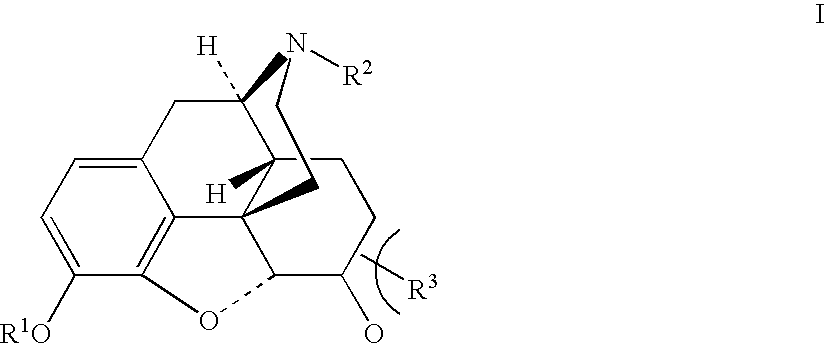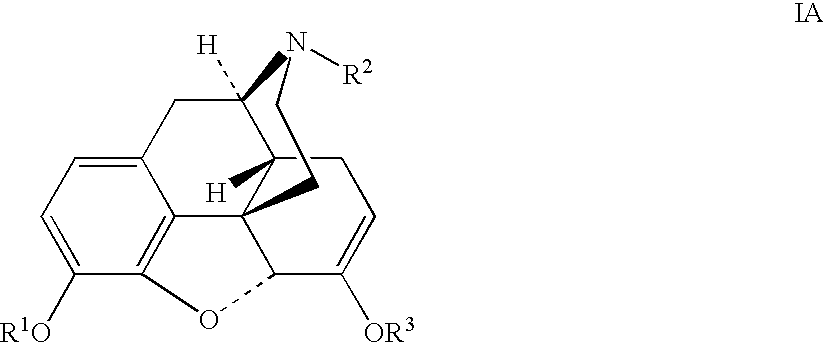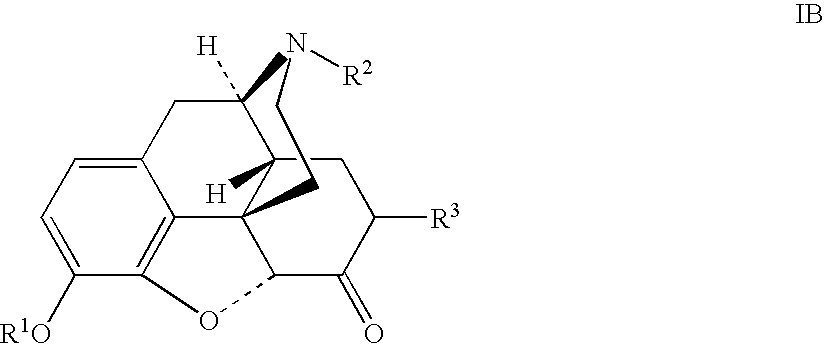Production of opioid analgesics
a technology of opioid analgesics and analgesics, applied in the field of opioid analgesic production, can solve the problems of substantial yield loss and unreliable quality of the resulting hydrocodon
- Summary
- Abstract
- Description
- Claims
- Application Information
AI Technical Summary
Problems solved by technology
Method used
Image
Examples
example 1
Dihydrothebaine
[0051] Dihydrocodeine (0.504 g) and benzophenone (2.22 g) were dissolved in cyclohexane (9 mL), then potassium tert-butoxide (0.59 g) was added, and the mixture was agitated under nitrogen at 30-50° C. for 4 hours and cooled to room temperature. Dimethyl sulfate (0.5 mL) was added dropwise to reaction mixture over a period of 20 minutes with cooling to 20° C. and efficient stirring. The mixture was agitated for 18 hours at room temperature, then extracted with 1.5N acetic acid (2.5 mL) and water (0.5 mL). The combined aqueous extracts (4.48 g) contained 0.426 g dihydrothebaine according to an HPLC assay. Purified dihydrothebaine, prepared by the Homeyer method (J. Org. Chem. (1956), 21, 370), was used as a reference standard for the HPLC assay. Solid dihydrothebaine was obtained from the solution via precipitation with aqueous sodium hydroxide.
example 2
Dihydrocodeinone Enol Acetate
[0052] Dihydrocodeine (0.502 g) and benzophenone (2.24 g) were dissolved in cyclohexane (9 mL), then potassium tert-butoxide (0.59 g) was added, and the mixture was agitated under nitrogen at 30-40° C. for 4 hours, then cooled to room temperature. Acetic anhydride (1 mL) was added to the reaction mixture in one portion with efficient stirring. The mixture was agitated for 30 minutes at room temperature and assayed by HPLC to contain 0.535 g of dihydrocodeinone enol acetate. Purified dihydrocodeinone enol acetate, prepared by the Small method (J. Org. Chem. Soc (1939), 3, 204), was used as a reference standard for the HPLC assay. Solid dihydrocodeinone enol acetate was obtained from the mixture via extraction with 1.5N acetic acid as in the previous example, followed by precipitation with aqueous ammonia.
example 3
[0053] Experiment A (reference): Hydrocodone preparation, including addition of acidified water to the reaction mixture containing hydrocodone enolate and potassium tert-butylate
[0054] Dihydrocodeine (5 g) and benzophenone (30.05 g). were added, under nitrogen, to a mechanically agitated mixture of benzene (100 mL, Experiment A1, Table 1) or cyclohexane (100 mL, Experiment A2, Table 1) and potassium tert-butoxide (5.6 g). The mixture was agitated at reflux (80-82° C.) for 2.5 hours and cooled to room temperature. 3N hydrochloric acid (25 mL) was added to the mixture over a period of 0.5 hours with cooling to 6-16° C. The aqueous layer was separated, the organic layer was washed with water (10 mL), and the aqueous extracts were combined. The resulting solution was analyzed by HPLC to determine the hydrocodone content [H %] and also the content of the major impurity, hydrocodone aldol dimer [HAD %] (Table 1).
[0055] Experiment B: Hydrocodone preparation, including the add...
PUM
| Property | Measurement | Unit |
|---|---|---|
| temperature | aaaaa | aaaaa |
| temperature | aaaaa | aaaaa |
| temperature | aaaaa | aaaaa |
Abstract
Description
Claims
Application Information
 Login to View More
Login to View More - R&D
- Intellectual Property
- Life Sciences
- Materials
- Tech Scout
- Unparalleled Data Quality
- Higher Quality Content
- 60% Fewer Hallucinations
Browse by: Latest US Patents, China's latest patents, Technical Efficacy Thesaurus, Application Domain, Technology Topic, Popular Technical Reports.
© 2025 PatSnap. All rights reserved.Legal|Privacy policy|Modern Slavery Act Transparency Statement|Sitemap|About US| Contact US: help@patsnap.com



